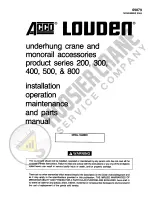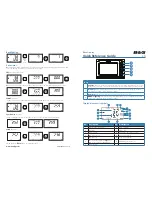
RTC
®
5 PC Interface Board
Rev. 1.9 e
8 Advanced Functions for Scan Head and Laser Control
179
innovators for industry
8.7.2 Compensation of Linear Move-
ments
Processing-on-the-fly correction for linear workpiece
movements can be activated via the list commands
or alternatively via the list
commands
and/or
or
via
or
(
Mode
= 1…3)
(1)
. A scaling factor must thereby be
specified.
, you can activate addi-
tional Processing-on-the-fly correction with posi-
tional values for linear motion in all three coordinate
directions without bit-resolution restrictions. No
scaling factor is required.
Processing-on-the-fly correction can be stopped
(simultaneously for both directions) via the command
(see the corresponding notes on
).
Correction via Encoder Counter(s)
If position values for Processing-on-the-fly correction
are forwarded via the internal encoder counters, then
Processing-on-the-fly correction must be activated
via
factor [in bits per count] defines the relation between
the shift [in bits] of the current output position in the
image field and one counter pulse (count) of the
corresponding encoder counter (see below).
The
or
respective encoder counter (Encoder0 or Encoder1)
to zero
(2)
.
Thereafter, the output value is calculated from the
current output position by adding (for each direction)
the product of the scaling factor and the current
counter value. This correction is performed every
10
µ
s
(3)
.
Notes
•
nation for 1D Processing-on-the-fly applications
(e.g. an obliquely angled conveyor belt) as well as
for encoder-based 2D Processing-on-the-fly appli-
cations (e.g. an XY translation stage), particularly
for separate or separable marking tasks in the real
image field. For continuous marking in the virtual
image field, SCANLAB instead recommends using
(see
).
Determining Scaling Factors
If the workpiece position is to be registered via one
(or two) incremental encoder(s), then a calibration
procedure will be required to determine the scaling
factor:
must be used to
determine the encoder increments i
x
and i
y
[in counts
per mm] for each direction:
Read the counter start value (via
and begin the movement
Stop the movement and read the counter end
value (via
(4)
Measure the distance travelled in mm
The encoder increment i can then be calculated as
follows:
i = (counter end value – counter start value) /
distance travelled
In a second step, the scaling factors
Scale
x
and
Scale
y
[in bits per count] can be calculated from the
determined encoder increments as follows:
Scale
x
= K
/
i
x
Scale
y
= K
/
i
y
whereby K is the calibration factor [in bits per mm]
(see
).
If the workpiece moves at a constant speed v
x
or v
y
[in mm per second] and an encoder simulation was
activated via
, then the scaling
factors are calculated as follows:
Scale
x
= K
·
v
x
/ (1000000 counts/s)
Scale
y
= K
·
v
y
/ (1000000 counts/s)
It might be necessary to adjust the signs of the scaling
factors to the direction of movement.
(1) There are restrictions on combining Processing-on-the-fly
corrections with each other (see the
(2) With
, bit#9 can be set in advance to deter-
mine whether the counter should reset immediately or only
after a subsequent start trigger (i.e. with a subsequent external
start signal,
command, possibly postponed by a track delay defined via
,
or
, bit#2).
If the counter only gets reset after the subsequent trigger, then
this effectively eliminates the 10
µ
s jitter (random time offset
between the start signal and the list start).
(3) The encoder counters are 32-bit counters (for signed 32-bit
values). If the maximum (minimum) count is reached, then
counting will continue with the minimum (maximum) count.
(4) Alternatively, the counter start and end values can be stored in
a buffer on the RTC
®
and then retrieved from there via the control command
















































